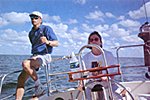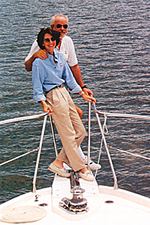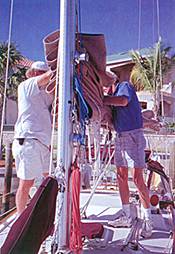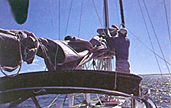|
The school, a division of Southwest Florida Yachts,
is located in North Fort Myers. SFY owners and managers,
Vic and Barbara Hansen keep a small fleet of power
cruisers ranging in size from 32 to 42 feet long
at Marinatown Marina in North Fort Myers. Another
small sailing fleet consisting of boats ranging
in size from 24 to 44 feet long occupy slips in
Marinatown and a short distance north of there at
Burnt Store Marina in Punta Gorda. The Hansens are
serious about boating and have made teaching others
the rules of safe boating and the correct way to
experience it their livelihood.
 |
|
When
students are at the helm (a wheel or tiller
that operates the rudder which steers the
boat.) Capt. Gary Graham doesn't get too far
away.
|
Founded
in 1984 by this pair of licensed captains, the school
has been in continuous operation for 15 years. It
has seven captains who can prepare even neophytes
for power cruising as well as basic sailing (Sailing
101) to coastal cruising right through bareboating.
Then they test students and see them through ASA
certification procedures for every level of recreational
boating expertise. If Florida ever starts requiring
licenses for boat owners, those sailors with ASA
certification will only have to pay for a license.
Others will be required to pass the same tests to
get licensed.
 |
|
Vic
and Barbara Hansen have made safe boating
their livlihood for 15 years now.
|
"There's
immense satisfaction in learning to do things the
right way," Barb Hansen says. Florida Sailing and
Cruising School has established a sound reputation
as one of the top seamanship schools in the country
through longevity and a philosophy that, according
to Vic Hansen, makes learning a special experience.
"We believe that people learn and remember when
they are having fun, and we believe they learn with
their hands, hearts and their heads," he says. "This
is the philosophy upon which we design all courses."
In addition, safety is emphasized in every course
whether it's power or sail. "Safety isn't boring.
Safety isn't mean," Hansen says. And teaching safety
shouldn't mean stern faces or raised voices.
This
immediately reminded me of the lesson I was given
years ago about watching out for the boomthe piece
that holds the main sail across the bottom and attaches
to the mast. My original instructor cracked me in
the head with it when I wasn 't looking. My black
eye was gone in a few days but, needless to say,
the memory of what the boom can do lingers on almost
two decades later and I've never been caught by
another one.
Having
had family in Tampa and Fort Walton Beach for a
long time, I'm fairly familiar with our west coast;
but Punta Gorda, situated on Charlotte Harbor just
south of Port Charlotte and Venice, was a totally
new and beautiful experience. The southwest coast
position of Punta Gorda is almost due west of our
southeast coast city of Ft. Pierce. From the Funcoast,
it's about a four-hour drive across I-4 then south
on I-75 for about 100 miles. Making this trip in
early January traffic was light and the weather
was beautiful. That time of year in Punta Gorda
afforded perfect temperatures and excellent sailing
conditions on Charlotte Harbor.
There
were two other students, Rob and Chayla Walton of
Sanibel Island, involved in my class which began
sharply at 8:30 a.m. Our school room was an Island
Packet 32 cutter named Argot and the Harbor was
our playground. Our captain was Gary Graham and
I have never met a more calm, cool and collected
skipper. Capt. Graham has been with the school for
10 years, and he seems qualified to handle just
about anything that could happen on a boat. In keeping
with the Hansen philosophy for learning, he made
our two-day session a lot of fun as well as entrenching
the things required by the course deeply enough
in us for us to pass our tests and become ASA certified
for the basic sailing skills level.
Before
we ever left the dock, our skipper-instructor spent
about two hours going over general boating information.
Some of it was review because the School sends out
in advance a copy of Sailing Fundamentals, the official
learn-to-sail manual of the American Sailing Association
and the U.S. Coast Guard (page break) Auxiliary
written by Gary Jobson. When students are at the
helm (a wheel or tiller that operates the rudder
which steers the boat), Capt. Gary Graham doesn't
get too far away. (upper photo caption this page)
Vic and Barbara Hansen have made safe boating their
livelihood for 15 years now. (lower photo caption
this page) If you're thinking about a sail boat,
it's a good idea to actually read this enlightening
book whether you have plans to go to such a school
or not.
Since
we were going to be sailing, we talked a lot about
sailing necessities. There are no ropes on a sail
boat except the one that runs up the luff edge of
the mainsail and fits inside the mast. Capt. Graham
made the names of all the non-ropes on a sailboat
finally make sense to me. It's really very simple.
Halyards raise and lower sails. Sheets let sails
out and haul them flatter for varying wind conditions.
No one ever put it to me that way before. I had
to just remember this was a halyard and that was
a sheet and oh yeahthat's a line.
 |
|
Capt.
Graham shows a student how to "flake"
the sail so that it fits inside the cover
better and is easier to raise.
|
We
practiced some knot-tying and at last I learned
why certain knots are required for different things.
Two half hitches for example is good for the ends
of lines. (Lines secure things ie: anchor to boat,
boat to dock etc.) Two half hitches form a knot
for a line that can be adjusted quickly without
being untied and retied something a sailor might
not have time to do for various reasons.
Of
course, if the line isn't secured to the dock or
boat somewere, well "This is the bitter end,"
Graham says, holding up the free end of a spring
line attached to the beam of our boat which goes
around a specific cleat at the dock when the boat
is in. "Why is it called the bitter end?" he asks
in response to our queries. "Because if it isn't
properly tied at each end and you cast off without
checking it, it can all disappear in the water.
And that's the bitter end." Which means, when you
come back to the dock and want to tie up the boat,
the line will be down on the marina bottom. Quit
laughing. These are the types of careless things
that can happen all the time, even to experienced
boaters.
During
our review and first-morning information session,
it occurred to me how much I was hearing for the
first time and I've been around boats most of my
life. "I wonder how many people out there," I say,
indicating boaters in general, "have all this information?"
His answer stuns me.
"When
you finish here," Graham replies, "you're going
to have 90 percent more information than 90 percent
of all the people out there. And the Coast Guard
will tell you the same thing." This is mind boggling
when the number of boaters loose on Florida's waterways
as well as the rest of the nation is taken into
consideration mind boggling, and pretty scary
when you really stop to think about it.
I
personally have seen dozens of power boaters (PBers)
who have no idea that a boat being propelled by
the wind always has the right of way. Why? Because
a boat under sail can't manuever like a power boat.
Their reaction time is much slower if the wind is
the powering agent. Even a sail boat running its
auxiliary engine must give way to a boat operating
under sail power only. Too many boaters just buy
a boat, put it in the water and take off without
any explanation or understanding of waterway rules.
Since
we sailed from Burnt Store Marina which is located
in a cove off Charlotte Harbor, our training area
was only minutes away from our dock. At Florida
Sailing and Cruising School, all students take turns
at various boat tasks so everyone learns the proper
way to perform every task which provides for a well-rounded
feel for the boat and how it handles.
Even
though our boat was a cutter (three sails), we sailed
it as a sloop using the main and the jib. I have
always known that a helm, whether it's a wheel or
a tiller, left unattended will usually turn the
bow of the boat into the wind until it puts you
in irons (no wind) but I never knew why. Capt. Graham
takes the mystery out of that.
"You'll
notice this boat has a weather helm," he tells me
when it is my turn at the wheel. "Some boats have
a lee helm, but most people want weather helms."
I hadn't known there was an option, and my expression
must tell him that, because he goes on. "If you
have a weather helm, you'll never have to worry
about the boat sailing off and leaving you if some
mishap occurs."
A
weather helm means the bow of the boat will turn
windward until it's pointing straight into the wind.
A sailboat pointed into the wind will stop forward
motion and drift in a neutral attitude. A lee helm
means the bow of the boat will turn away and put
its stern to the wind. A sailboat has forward motion
with the wind behind it.
"With
a lee helm," our Skipper says, "the boat can turn
down wind and run off on its own. And you'll be
swimming after it."
 |
|
When
the main sail is dropped, it comes down on
the boom where it's secured then covered up
until the next sail. Most sailors leave it
in a unsightly pile, the way it's seen here.
|
The
man was psychic! Years before I really got into
sailing, that very thing had happened to me with
a cousin and his new sailing dingy. We got becalmed
on a large lake. Without knowing enough to fix the
tiller's position and luff the sail, (leave it (upper
photo caption this page.) Capt. Graham shows a student
how to "flake" the sail so that it fits inside the
cover better and is easier to raise. (lower page
photo caption this page.) When the main sail is
dropped, it comes down on the boom where it's secured
then covered up until the next sail. Most sailors
leave it in an unsightly pile, the way its seen
here. loose) we finally started swimming behind
the stern and pushing the boat ahead of us because
a huge black thunderhead looming on the horizon
was coming our way.
A
sudden gust of wind came up and caught the boat,
swirling the sail around and it took off much faster
than we could swim. We had to swim all the way back
to shore while the boat bobbed merrily along the
lake bank. When we got there, it led us a happy
chase before we harnessed the rascal and got it
back on the trailer. By the time we got inside the
car, we were working feverishly in an all-out gusty
summer thunderstorm.
Sailors
don't just start up an engine and "ride there."
They use the wind to take them wherever "there"
is. It's a sport or a pastime that really requires
expertise and skill since the wind might not be
coming from the direction you need it to be for
it to take you where you want to go. So, you have
to learn how to use the sails to get the boat to
its destination no matter how fickle the breezes
are. Sailors are always tacking, steering, sheeting
in, easing out and otherwise trimming sails to get
the best results from air that's often quite invisible.
Wenching jibs and hauling main sheets while they're
filling with wind can be real workouts.
Keeping
track of where the wind is in relation to the course
and keeping the boat properly trimmed makes sailing
an interesting sport to master. It even has a separate
language all its own so the Captain can give commands
with as few words as possible.
The
wind, by the way, is free fuel which is why so many
sailors go island hopping and some even go around
the world. Under sail you can speak in a conversational
tone or even whisper and be heard. On a sailboat,
you can actually hear the water lapping against
the hull as the bow slices through the chop.
Unless
you're just riding the coastal breezes which are
fairly constant, sailors keep pretty busy and our
hands-on sailing classes in the Harbor were good
workouts. I hadn't worked like that since my racing
days on Lake Lanier. Anyone thinking of trying out
the school shouldn't go into one of these classes
thinking they're going to spend the day just riding
around in breezy sunshine. Students are there to
learn and instructors are there to see that you
do. The first day, filled in a lot of gaps in my
previous haphazard training and left me ready for
bed at a very early hour.
The
second day was all new information. We spent the
second whole morning learning and practicing man-over-board
(MOB) retrieval. There is a real science to getting
a sailboat back to someone in the chop and picking
them up safely. I had never had this training and
I shudder to think how many more sailors are winging
around on the water without any knowledge of these
crucial procedures.
Each
student played the role of skipper, spotter and
retriever until we performed every task to Capt.
Graham's satisfaction. That alone, is worth the
price of the first-level course. I know I left there
feeling much better about my own sailing skills.
Receiving professional training boosted my confidence
and made me feel more secure about many things that
had only been vague notions.
If
you have read Unfinished To Boat or Not to Boat
in this issue, and are one of those people deciding
about a boat of some kind, you owe it to yourself
to seriously consider accredited schooling somewhere
before you make up your wind. Marine insurance companies
will certainly balk on any claim if it's discovered
that ignorance of waterway rules played a role in
some kind of boating mishap.
For
peace of mind and calm assurance on the water, get
informed. Practice boating safety. Your life and
the lives of your passengers depend on it.
For
more information on the power boat and sailing courses
offered by Florida Cruising and Sailing School,
call 1 (800) 262-SWFY (7939) or (941) 656-1339 or,
take a look at their websites, www.swfyachts.com
and www.flsailandcruiseschool.com.
Electronically
redistributed with the permission of Halifax Magazine.
http://www.halifaxmagazine.com
Click
here for basic boat etiquette
|